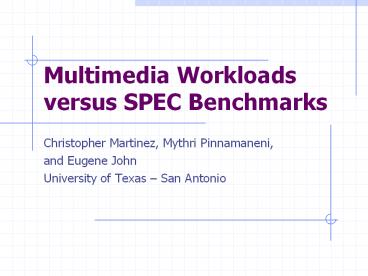Multimedia Workloads versus SPEC Benchmarks - PowerPoint PPT Presentation
Title:
Multimedia Workloads versus SPEC Benchmarks
Description:
MP3/AAC iTunes, Winamp, RealPlayer. Video Windows Media Player. Encoding ... iTunes MP3 Encode. 2.02. RealPlayer MP3 Encode. 2.02 / 1.82. Video Encode Pass1/Pass2 ... – PowerPoint PPT presentation
Number of Views:92
Avg rating:3.0/5.0
Title: Multimedia Workloads versus SPEC Benchmarks
1
Multimedia Workloads versus SPEC Benchmarks
- Christopher Martinez, Mythri Pinnamaneni,
- and Eugene John
- University of Texas San Antonio
2
Outline
- Motivation
- Multimedia Workloads
- Cycles Per Instruction
- Branch Prediction
- Cache Performance
- Conclusion
3
Motivation
- The common workloads for the home user now focus
upon entertainment - For the home user entertainment performance is
the selling point - There are many media benchmarks but can SPEC
benchmarks give some insight to entertainment
applications?
4
Objective
- Understand the performance characteristics of
multimedia workloads - Compare them against SPEC CPU 2000
5
Multimedia Workloads
- Codecs used include mp3, aac, MPEG2(dvd),
windows media(dvd, HD), and MPEG4 - Examine multimedia playback and creation
(decoding/encoding)
6
Multimedia Workloads
- Decoding
- MP3/AAC iTunes, Winamp, RealPlayer
- Video Windows Media Player
- Encoding
- MP3 iTunes, Windows Media Player, RealPlayer
- AAC iTunes, RealPlayer
- Video Windows Encoder
7
Multimedia Workloads
- MP3 files used a bitrate of 128kbps
- AAC files used a bitrate of 128kbps
- Video files used presets from applications
- Video was a TV capture of a football game
- Audio encoding was done on Beethoven Symphonie
Pastoraie - Audio playback was done on Boulevard Of Broken
Dreams by Greenday
8
Performance
- Performance based on common measurements cycles
per instruction (CPI), uops per instruction,
branch prediction, cache hit rate - Use on chip performance counters on the Pentium 4
processor - Use Vtune to capture the on chip counters
9
CPI
- Our test were performed on a Pentium 4 which is
capable of executing 6 micro operation per second
(uops) - Audio decoding CPI --- 1.85 - 3.55
- Audio encoding CPI --- 1.40 - 2.11
- Video decoding --- 1.96 - 2.56
- Video encoding --- 1.82 and 2.08
- Integer SPEC 2000 CPI --- 1.16 - 8.54
- Floating SPEC 2000 CPI --- 4.72 8.31
10
CPI
11
uops
- Audio decoding uops --- 1.38 1.71
- Audio encoding uops --- 1.30 1.41
- Video decoding uops --- 1.28 1.43
- Video encoding uops --- 1.29 1.31
- SPEC 2000 integer uops --- 1.29 2.11
- SPEC 2000 float uops --- 1.32 2.48
12
Branch Prediction
- SPEC benchmarks have a large percentage of branch
instructions than media applications - Audio decoding -- 12 branch instructions
- Audio encoding -- 7 branch instructions
- Video decoding encoding -- 8 branch
instructions - SPEC -- 13 - 20 branch instructions
13
Branch Prediction
- Media and SPEC benchmark exhibit a high branch
prediction rate - Prediction rates of 94 and higher in most cases
- With media application there is a high
correlation between misprediction and CPI
14
Branch Prediction
15
Cache Performance
- The Pentium 4 processor has two level cache
- 1st level 16KB 2nd level 1MB
- Multimedia deals with data in a linear fashion
- Audio/Video must be played in order
- This sequential data should allow for high hit
rates - Since SPEC benchmark covers a wide application
range not all benchmarks will resemble the media
hit rates
16
1st Level Cache Performance
- For 1st level cache hit rates the multimedia had
hit rates of 93 and higher - Half of the SPEC benchmarks had similar 1st level
hit rates - Remainder of the SPEC benchmarks were
considerable worst performance
17
1st Level Cache Performance
18
2nd Level Cache Performance
- For all multimedia application 2nd level cache
had a hit rate of 99.8 or greater - Only 5 of the 14 SPEC benchmarks had similar 2nd
level hit rates - Most of the remaining SPEC benchmarks had 98 or
higher but 2 SPEC had 86
19
2nd Level Cache Performance
20
Conclusion
- Audio and video have similar range in CPI, uops
per instruction, and uops per cycle - SPEC programs exhibit performance characteristics
in a much larger range than media. i.e SPEC
suites are very diverse
21
Conclusion
- Both audio and video are comparable to SPEC in
2nd level cache performance - Half of the SPEC benchmarks resemble audio and
video in 1st level cache - SPEC benchmarks can give some insight into
performance of media applications
22
CPI
23
CPI
24
uops
25
uops
26
uops
- Besides just similar number of uops one can also
look at the cycles to complete the uop
27
uops
28
Branch Prediction
Audio Decoding
29
Branch Prediction
Audio Encoding
30
Branch Prediction
Video
31
Branch Prediction
32
Branch Prediction
- The high correlation between branch prediction
and CPI can give improvement insight - When new CPU enhancements show improvement in
SPEC, a similar or higher gain will be observed
in multimedia applications































